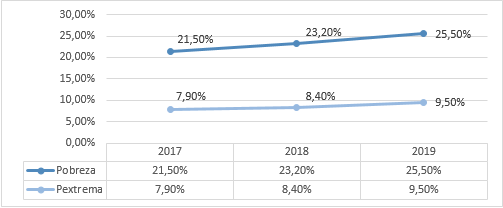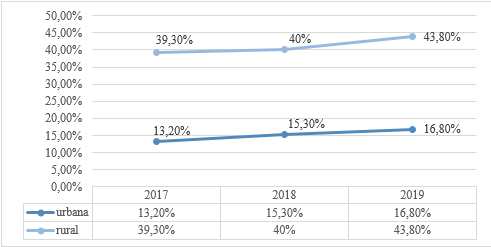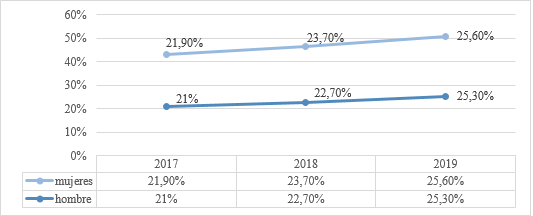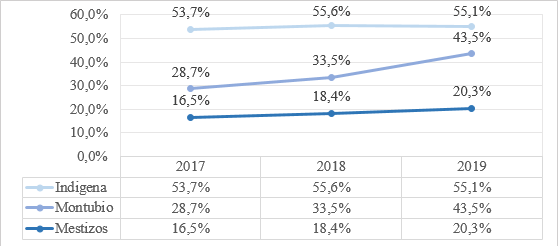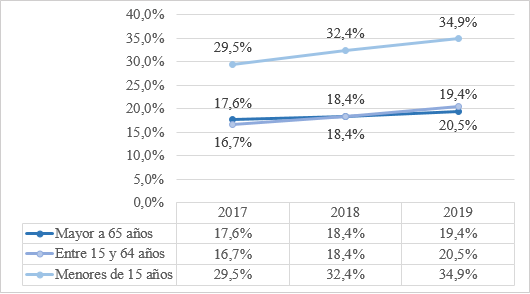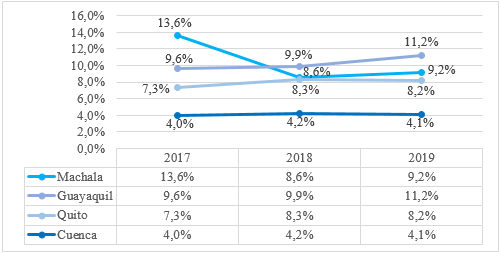Introduction
Poverty is and has been a topic of interest to ordinary people, students, academics, specialists in social sciences and international organizations. Interest is born because poverty is considered one of the main social problems that affect many countries, even more those that have an underdeveloped economy. Easily access basic goods and services is one of the limitations of families whose economic level is low; more specifically, poverty is a condition that affects different aspects of human well-being and good living and usually manifests itself in different forms such as: lower income level, low consumption level, social exclusion and even high mortality rates (Mood & Jonsson, 2016).
The present work refers to the problem of poverty in Ecuador, with the objective of identifying through the use of two approaches to poverty measurement, the existing levels of this phenomenon in the country and at the same time to determine if there have been significant variations during the years 2017 to 2019.
From the point of view of economic policy it is important to be able to know the degree of intensity that families suffer from different needs and establish ideas that can remedy this problem. The results determined that the level of poverty during the last three years has been increasing; the changes that the Ecuadorian economy has had have been reflected in this phenomenon of poverty.
Development
Poverty is more than the lack of income and resources, to guarantee a sustainable life, it is a problem of human rights, understood as hunger, malnutrition, not having access to decent housing, unlimited access to basic services, health, education, without neglecting discrimination and social exclusion.
Poverty is the approach as income shortage, a person is considered poor if they reside below an established monetary threshold; The incidence of poverty is higher among people living in rural areas, children, adolescents, youth, indigenous people, women, people with lower levels of education, and people who have unsatisfied basic needs.
The situation of poverty bears an attack on dignity, also implies the vulnerability of several rights; the core of poverty involves the existence of some basic needs of an urgent nature that do not allow people to achieve a decent life (Beca, 2018).
According to Zabalza (1987), it refers to the deficiencies that an individual or society suffers, it is considered if compared to a certain standard. Considered as the insufficiency of essential goods and services for the individuals of society.
Quality of life
According to Jacobs (1996), you can identify the quality of life with disposable income, if individuals have more money, their consumption will be higher, which means that they will have enough money to meet their needs, but observing another origin we can understand that people also need services, which are divided into public: health, education, sewer, among others, and the second is welfare that are not tradable, therefore the quality of life is the collective consumption of goods and services in order to obtain social welfare.
Resource insufficiency
It is understood as a shortage or lack of an individual in society to cover their basic needs of both goods and services, that is, they do not have sufficient income to satisfy human societies in different aspects.
Social exclusion
According to Buvinić (2004), he mentions that social exclusion is related to the issue of relative and absolute poverty and to inequality, it is linked to both income distribution, social privatizations and lack of power in society.
Inequality
There are different types of inequality within them are: social inequality, income, etc. When referring to social inequality is the reduction of education, it is related to the complexity of getting a job, and therefore income inequality due to lack of education will not be able to meet basic needs as a result of lack of income of the individual (Solís, 2017).
Economic development
It is related to the productive capacity of a country and is directly linked to the well-being of people, it is evident that there is a development through the distribution of income, sustainability, etc.
Redistribution of income: within the distribution of income can affect unprotected groups and therefore redistribution allows disadvantaged individuals to receive help in order to improve the situation.
Sustainability: satisfaction of present needs without compromising the ability to meet the needs of future generations, thus maintaining an economic, social and environmental balance.
According to Arce (1965), it implies a change in living standards, such as the social structure, allowing large masses to access middle-class levels, in other words the reduction of the lower classes and, in turn, reduce the existing social-economic problems.
It implies the development of human and social capital in a country, that is, evolution in favor of the relations of the people or groups of a society.
There are several approaches to analyze poverty, which depend on the geographical context in which it is analyzed and the historical period considered, on the extent of the effects. It is a social condition that limits several people from being able to meet all basic needs and even has a lower welfare than the established minimum. The observable consequences of poverty, considering as the two most important methods; indirect method / (income or consumption) and direct method (unsatisfied basic needs (GNI), the first method refers to the measurement of the standard of living through household income, which is defined with the minimum cost of the basket of goods and services (Espinoza & Tejada, 2015).
Likewise, for the measurement of the first method, food needs are taken into account as a starting point, where the nutritional requirements for the preparation of the basic basket are covered, covering the minimum costs. The prices of the Basic basket vary according to the stipulated in the Consumer Price Index and requirements according to area, sex, ethnicity, age, city and region will be taken into account (Eguía, 2017).
Extreme manifestation of several inequalities, insufficient monetary resources to reach the optimum level of well-being with human dignity, due to the privatization of access to basic goods and services, are causing income inequality to generate disincentives for innovation in the country.
Contrary to the evolution of poverty by income, the Unsatisfied Basic Needs Index (NBI) expresses constant reductions throughout the seventies, eighties and with a tendency to stabilize in the nineties, both in rural and urban areas, reflection of the lower deficiencies of certain goods and services that are considered basic for the subsistence of households (Gómez & Duque, 1998).
Currently, in the cities of Latin American countries, the recent profile of poverty is characterized by the continued increase in people in conditions of poverty and other deprivations, while the NBIs show a setback. In exchange for these improvements, attributed to certain benefits of urbanization, the worsening of urban exclusion mechanisms is observed through deficit access to collective consumption goods (Cordera, Ramírez & Ziccardi, 2008).
The Index of Unsatisfied Basic Needs as a method to measure the level of poverty of a country, was introduced by the Economic Commission for Latin America and the Caribbean in the early eighties, with the objective of taking advantage of the information obtained from demographic censuses and of housing for poverty characterization (Lechuga Cardozo, 2018).
NBIs are referred to a situation of deprivation that prevents people and families from being able to reach minimum levels of good living and well-being according to specific criteria; specifically, it is the dissatisfaction of a set of essential needs that reflect the style and way of life of a given society.
There are several types of methods to measure poverty, the method based on income and consumption refer to the individualization of poor households with respect to their capacity of bins and services necessary to meet their basic needs. On the other hand, Eriz & Fernández (2015), refers to the NBI approach, which basically consists of verifying whether households have satisfied a series of previously established needs and considers those who have not achieved it to be poor.
According to Moreno (2017), this method consists in “establishing a set of needs that a society considers must be met by households (essential or basic needs), the minimum satisfaction threshold and confront the situation of the households analyzed with respect to them”. (p. 141)
According to Lombeida & Serrano (2020), the Unsatisfied Basic Needs (NBI) method characterizes the population based on certain critical deficiencies; if the household is lacking in at least one of the components, household members are considered poor by NBI; In Ecuador, a person is poor or not, by NBI, based on five components:
Materials and methods
In order to carry out this research on the analysis of poverty in Ecuador, the implementation of the analytical-synthetic method was considered; according to Bernal (2010), this research method studies the facts, since it starts from the decomposition of the object of study in its different parts to carry out an individual study, and then synthesize those parts; that is to say studying them in an integral way. The statistical data corresponding to the 2017-2019 years obtained from INEC and the Central Bank of Ecuador were: Poverty measurement approaches (Poverty and Inequality by income and Poverty by Unsatisfied Basic Needs), Poverty and extreme poverty, Poverty by area, sex, ethnicity, age, city and region. Statistical analyzes and graphs are based on the important levels of incidence of poverty in the country, finally the results indicate that the levels of this social problem are increasing even more in the Amazon region.
Results and discussion
A state without the presence of poverty is the priority of the objectives of global economic policies and even more in Latin American countries. The variables such as poverty and extreme poverty, geographic area, sex, ethnicity, age, cities and region were considered to analyze the level of poverty in Ecuador, after a statistical analysis it was demonstrated that the level of poverty in the country evidently ah It has been increasing since 2017 when the Lenin Moreno government period began.
With the realization of statistical tables and graphs it is possible to verify the evolution of poverty during the years 2017 - 2018 and 2019, evidencing in table 1 and 2 the level of poverty existing in the country, obtained through the measurement approaches that are used in the INEC that are: Poverty and Inequality by Income and Poverty by Unsatisfied Needs. In both tables it is possible to observe that the year 2019 is the one that presents the highest level of poverty at the National level (Fig. 1).
Poverty and extreme poverty in the last three years of Ecuador, compared to the first half of 2019, poverty stood at 25.5%, while extreme poverty had a percentage of 9.5, which indicates that there was an increase in poverty of 2.3% and extreme poverty of 1.1%.
In the results of poverty by area (Fig. 2) in the last three years of Ecuador, compared to the first half of 2019, the urban area had an increase to 16.8%, while the rural area valued at 43.8%, representing an increase with respect to 2018 (fig. 3).
With data from the Central Bank in the first half of 2019, the country's poverty by sex was; Women presented a value of 25.60%, while for men it was 25.30%, it was evident, and poverty by sex there is an insignificant difference between men and women, while with respect to the previous year it also presents non-significant variations (Fig. 4).
As can be seen, ethnic poverty has been increasing during the last three years; In the first half of 2019, the incidence of national poverty by ethnicity was 20.3% for mestizos, 43.5% for montubios and 55.1% for indigenous people (Fig. 5).
The results show that, in the first half of 2019, the age groups of children under 15 years of age, between 15 years and 64 years and over 65 years presented urban poverty incidence rates of 34.9%, 20.5 %, and 19.4% respectively. The incidence of poverty with respect to the first two age groups has had a significant variation considering the previous year (Fig. 6).
With data from Instituto Nacional de Estadísticas y Censos of Ecuador as of December 2019, poverty in the four main cities of the country was; Cuenca (4.1%), Quito (8.2%), Guayaquil (11.2%) and Machala (9.2%). Obviously it is possible to visualize that the city with the highest poverty rates is Guayaquil and continued by the city of Machala since its variation is more significant with respect to the rest of the cities (Figure 7).
During the first half of 2019, the incidence of national poverty by region was 25.8%, 22.8% and 42.1% corresponding to the Costa, Sierra and Amazon regions respectively. The Costa and Sierra provinces presented a significant increase over the previous year; however, the Amazon region, having the highest percentage of poverty, for the first half of 2019 had a significant decrease.
Conclusions
Poverty, according to several authors, states that it is a priority in state policy decisions, therefore it is considered one of the main social problems that affect various countries, and more directly to those who have an underdeveloped economy. In Ecuador, through the use of poverty measurement approaches, which are the Income and Unsatisfied Basic Needs approach, it is clearly evident that poverty levels in the last three years have been increasing significantly.
From the present investigation it is concluded that poverty in 2019, has had an increase in different aspects such as poverty and extreme poverty, geographical area, sex, ethnicity, age, cities and regions, thus demonstrating that poverty is a social phenomenon that It does not distinguish conditions from people, besides it affects the development of the country.













